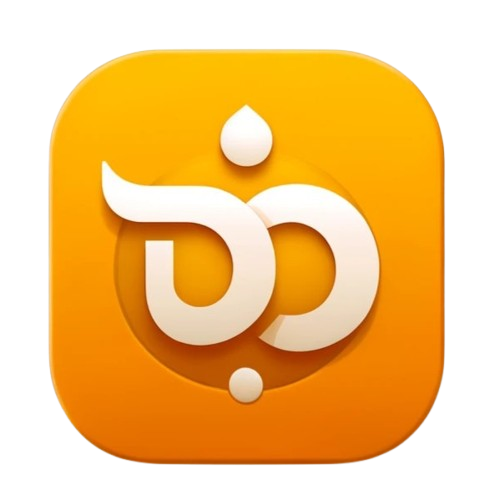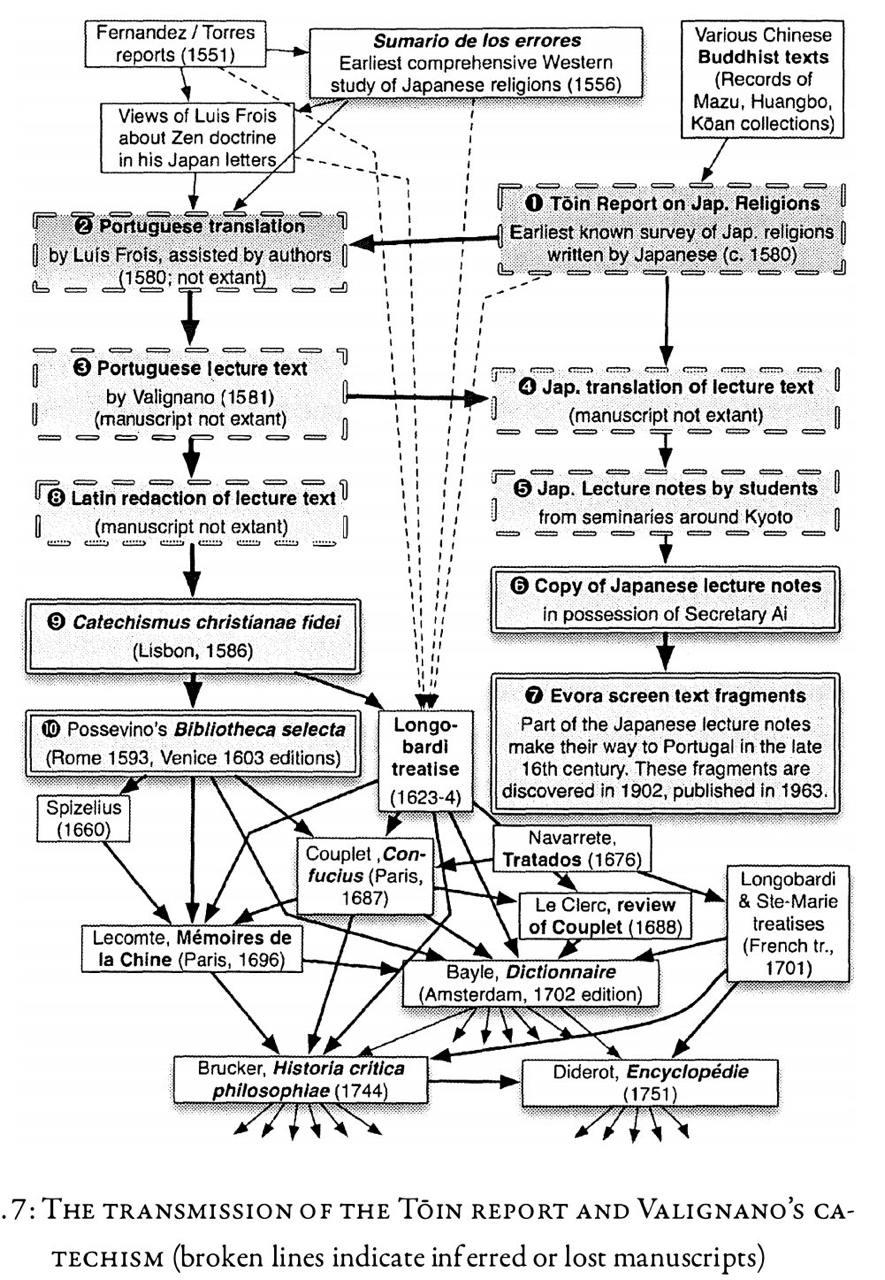Detailed explanation of A very important diagram above.
How the Jesuit scholar-missionaries in the 16th century imported and transmitted Indian Mahāyāna manuscripts throughout Europe.
Virtually every 17th-19th century western thinker was exposed to the high philosophy contained in these texts. These advanced texts were lost in India for centuries after the burning of Nalanda university in 1193 CE.
This proves that the Jesuit scholar-missionaries were actively engaged in gathering knowledge from the world over, digesting it into Latin, erasing the pagan sources and diffusing it all over Europe. A similar map should be made for the transmission of Calculus manuscripts from Kerala beginning with Matteo Ricci(1580s). If they could extract so much from China and Japan where they had zero power, imagine what they could have done in the kingdom of Kochi which was under Portuguese colonial control from 1500–1663. Sadly, the Kerala school of Mathematics was located in Kochi and, some of its scholars like Sankara Varier served directly at the royal court and some like Sankara Varman were themselves from the royalty! The latter readily shared his manuscripts with the British officer Whish in the 1820s. His predecessors would naturally have done the same for the Portuguese Jesuits if they asked for local manuscripts.
So what novel ideas did these Mahāyāna manuscripts contain?
-Realism vs Idealism debate (The west had it just 200 years ago!)
-"Transcendental Idealism"=Vijñānavāda
-Advanced treatises of logic(Candrakīrti and Dharmakīrti ?)
-Separation of Ethics & religion (Śāntideva)
-Utilitarianism
-Separation of conventional truths and ultimate ones(Nāgārjuna)
-Rejection of 'soul' and its consequences('Existentialism')
etc
Ideas, you see...are contagious!
Additional Fun fact- The early text "Sumario" was actually brought to Goa from Japan by Nunes Barreto in 1556. Multiple copies were created (possibly at the Goan St. Paul College) and shipped to Europe. So Goa (and Kochi obviously) was being used as the port of manuscript export by the Portuguese as early as 1550s. One can only imagine how many local Indian texts they managed to procure in that 150 year period.
-Ref for diagram above- The Cult of Emptiness: The Western Discovery of Buddhist Thought and the Invention of Oriental Philosophy, by Urs App.
Research by Joseph T Noony, a Mallu Christian
How the Jesuit scholar-missionaries in the 16th century imported and transmitted Indian Mahāyāna manuscripts throughout Europe.
Virtually every 17th-19th century western thinker was exposed to the high philosophy contained in these texts. These advanced texts were lost in India for centuries after the burning of Nalanda university in 1193 CE.
This proves that the Jesuit scholar-missionaries were actively engaged in gathering knowledge from the world over, digesting it into Latin, erasing the pagan sources and diffusing it all over Europe. A similar map should be made for the transmission of Calculus manuscripts from Kerala beginning with Matteo Ricci(1580s). If they could extract so much from China and Japan where they had zero power, imagine what they could have done in the kingdom of Kochi which was under Portuguese colonial control from 1500–1663. Sadly, the Kerala school of Mathematics was located in Kochi and, some of its scholars like Sankara Varier served directly at the royal court and some like Sankara Varman were themselves from the royalty! The latter readily shared his manuscripts with the British officer Whish in the 1820s. His predecessors would naturally have done the same for the Portuguese Jesuits if they asked for local manuscripts.
So what novel ideas did these Mahāyāna manuscripts contain?
-Realism vs Idealism debate (The west had it just 200 years ago!)
-"Transcendental Idealism"=Vijñānavāda
-Advanced treatises of logic(Candrakīrti and Dharmakīrti ?)
-Separation of Ethics & religion (Śāntideva)
-Utilitarianism
-Separation of conventional truths and ultimate ones(Nāgārjuna)
-Rejection of 'soul' and its consequences('Existentialism')
etc
Ideas, you see...are contagious!
Additional Fun fact- The early text "Sumario" was actually brought to Goa from Japan by Nunes Barreto in 1556. Multiple copies were created (possibly at the Goan St. Paul College) and shipped to Europe. So Goa (and Kochi obviously) was being used as the port of manuscript export by the Portuguese as early as 1550s. One can only imagine how many local Indian texts they managed to procure in that 150 year period.
-Ref for diagram above- The Cult of Emptiness: The Western Discovery of Buddhist Thought and the Invention of Oriental Philosophy, by Urs App.
Research by Joseph T Noony, a Mallu Christian
Detailed explanation of A very important diagram above.
How the Jesuit scholar-missionaries in the 16th century imported and transmitted Indian Mahāyāna manuscripts throughout Europe.
Virtually every 17th-19th century western thinker was exposed to the high philosophy contained in these texts. These advanced texts were lost in India for centuries after the burning of Nalanda university in 1193 CE.
This proves that the Jesuit scholar-missionaries were actively engaged in gathering knowledge from the world over, digesting it into Latin, erasing the pagan sources and diffusing it all over Europe. A similar map should be made for the transmission of Calculus manuscripts from Kerala beginning with Matteo Ricci(1580s). If they could extract so much from China and Japan where they had zero power, imagine what they could have done in the kingdom of Kochi which was under Portuguese colonial control from 1500–1663. Sadly, the Kerala school of Mathematics was located in Kochi and, some of its scholars like Sankara Varier served directly at the royal court and some like Sankara Varman were themselves from the royalty! The latter readily shared his manuscripts with the British officer Whish in the 1820s. His predecessors would naturally have done the same for the Portuguese Jesuits if they asked for local manuscripts.
So what novel ideas did these Mahāyāna manuscripts contain?
-Realism vs Idealism debate (The west had it just 200 years ago!)
-"Transcendental Idealism"=Vijñānavāda
-Advanced treatises of logic(Candrakīrti and Dharmakīrti ?)
-Separation of Ethics & religion (Śāntideva)
-Utilitarianism
-Separation of conventional truths and ultimate ones(Nāgārjuna)
-Rejection of 'soul' and its consequences('Existentialism')
etc
Ideas, you see...are contagious!
Additional Fun fact- The early text "Sumario" was actually brought to Goa from Japan by Nunes Barreto in 1556. Multiple copies were created (possibly at the Goan St. Paul College) and shipped to Europe. So Goa (and Kochi obviously) was being used as the port of manuscript export by the Portuguese as early as 1550s. One can only imagine how many local Indian texts they managed to procure in that 150 year period.
-Ref for diagram above- The Cult of Emptiness: The Western Discovery of Buddhist Thought and the Invention of Oriental Philosophy, by Urs App.
Research by Joseph T Noony, a Mallu Christian
0 Kommentare
0 Anteile
2KB Ansichten
0 Vorschau


